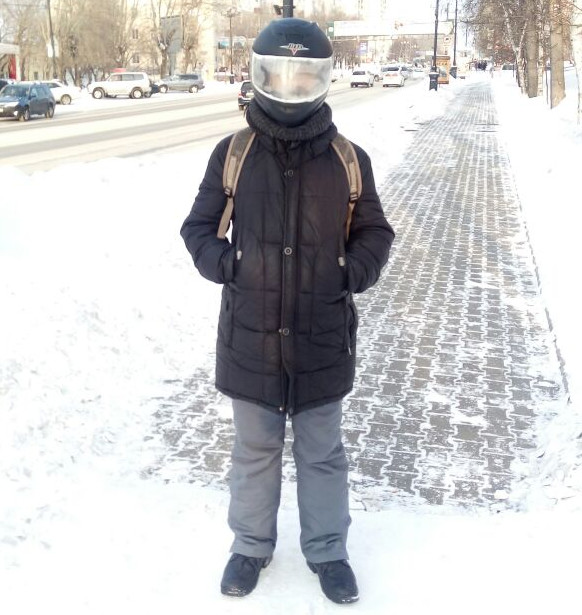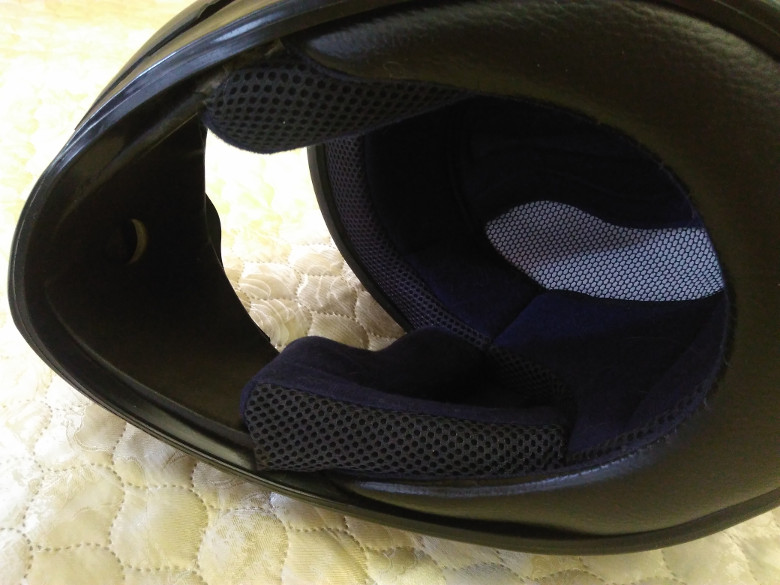The experience of using a pedestrian helmet to protect against low temperatures in the winter in the Far East of Russia
This article, for good, should not be here, since the scientific nature of the conducted research is left ... err ... do not match ... err ... is missing. Nevertheless, I reserve the right to believe that it still has some scientific novelty and relevance (at least two months a year in Siberia and the Far East). In addition, after an article about mattresses appeared in the health boom hub ...
So, as I think I look when I wear a motorcycle helmet in winter:

')
How I actually look:

Twenty-first century, humanity invented the holofiber, ski pants and Alaska jackets. Living with all this in even -30C is, in principle, comfortable. But each time, breaking through the winter at nine o'clock in the evening from work through the snow and wind, I thought “why did humanity not invent something to protect its face from a strong wind ... wait ... or invent?”. But seriously, I have depression and fear of cold every October (is there a Latin name for this?).
What is important in a motorcycle helmet: the reliability of protection, good ventilation, reliable fixation, affordable consumables - this is all for motorcyclists, we didn’t see this. We don’t have to fall at the speed of a motorcyclist, native ventilation at pedestrian speed will not work anyway, the shield (according to scientific - a visor) with careful use will live for decades.
Based on the above, after a thorough market research, the BLD motorcycle of the "integral" type was chosen, it was possible to buy it for 1000 rubles for Avito. The helmet visor is attached to the helmet on quick-release fasteners of an unknown standard (by the way, is there any standard for mounting the visor? Motorcyclists, please tell us), the softening protective layer is made of mesh covered with foam rubber and attached to the plastic with a hot-melt gun. The protection of the cheeks is realized by separate pads, which made it possible to dismantle them (after that, at the same time, it was possible to remove the straps). Before dismantling, it was rather hard to breathe because of the small amount of air in the helmet, because of which the movement speed was limited to about 2 km / h, when moving faster, it began to choke, after dismantling, the movement speed became limited to visibility conditions (I have a vision -7).
The second complicating factor was the fact that I have a sore neck (partly because I decided on this experiment, it was suggested that in winter the neck hurts more because of the constant instinctively pressing my head into the shoulders from the cold). In order not to burden the neck, I wore a large scarf, from above I “pressed” it with a sleep and put a helmet on the resulting construction. The pressure on the crown was barely felt, but you feel like in the Atlas robot from Mehvarrior - a review around just by turning the case.
Just immediately after the purchase, a rigid film was glued on the inside of the visor from the inside with a silicone sealant (at first it planned to stick a protective film for the tablet, but found an ordinary A4 transparent plastic sheet in the bins). The function is to seal the top gap of the visor and create an air thermal gap to reduce fogging (“conductor window” effect). By the way, this did not solve the problem of fogging, I had to use the old old-fashioned biker method and periodically lubricate the visor from the inside with detergent “Ushasty Nyan.” At the same time, the condensate does not collect in droplets, but spreads out like a film and does not interfere with the view. There are plans next year to try to make active blowing glass with a fan or impeller (I’m afraid I’ll blow into the eye) or apply a thin layer of transparent silicone sealant to the visor from the inside. Ideas are welcome.
I started wearing a helmet at the end of October to work and sometimes for walking around the center, I finished at the beginning of March.
Conclusions: acockroach can not hear without legs
Fulfills in full, at a temperature of -25 "overboard" and a wind of 10 m / s in the helmet, a comfortable temperature and a pleasant breeze slightly blowing over the visor and through the vents. If at this moment you feel like a city madman, then it is enough to raise the visor for 10 seconds and you immediately understand - nah, you are not crazy here. The “upper comfortable” ambient temperature is about -15 ° C, the helmet does not have time to go out of the helmet, it becomes too hot, you have to open the visor, the cold wind blows on wet skin, which in my opinion is not very healthy. Ergo - the optimum temperature for wearing a helmet from -15 to -25 degrees Celsius.
To be honest, there is not enough statistical data for any conclusions. Yes, worse than my neck this winter is gone, but for me the last couple of years, in principle, in this aspect is better. I will continue to observe. It's nice that you can walk around the city in the very cold weather, especially since the doctor prescribed 6000 steps on foot every day, as the most effective way to control weight. An interesting effect - in deep January on a sunny day there is a feeling as if it is already spring. Rapid self-reflection revealed the reason: heat + high humidity in the helmet + sun = the subconscious thinks that spring gives the corresponding emotional correction. I went through the winter very easily and without depression, although this is also not a regularity - winter was mostly -15 ...- 20C, which by our standards is very light and only a couple of days the temperature dropped over -25C. Plus, the overall emotional recovery from successful notions. I will also continue to observe.
Surrounding people treated with understanding, without aggression, once I was told “hey where the bike was left” (they returned my karmic debt, I once said, for fun, told a peasant with ice sticks for walking, “hey, man, you forgot to ski at home”). In fairness, despite the formal status of the capital of the Far East, in fact, in the constellation of the Far Eastern half-million, Khabarovsk occupies rather a cultural niche of St. Petersburg (guess who we are in Moscow) and the inhabitants of this city are famous for their unobtrusive, original and slightly eccentric character. In short, here we are accustomed to all durikami. Ecylopes did not dig, in principle, wearing a closed helmet is nothing illegal, just do not accidentally stray at a rally, there are special laws according to which purely pi is three, sine is two, and wearing a mask is 150 thousand rubles. up to 300 thousand rubles.
How I solved the problem with glasses. Yes, nothing. Ordinary glasses mist over instantly, I tried small-hole iron glasses - they just can't see anything. It turned out my -7 is enough not to crash into pedestrians on the street, to see the nearest relief, to see the running lights of cars and cross the road at the traffic lights. At unregulated crossings, he simply raised his visor and put on his glasses while he was crossing the road. Recently I learned about the existence of swimming goggles with diopters on Aliexpress, maybe next year I will try them.
To summarize: Experience has shown the fundamental possibility of using a helmet to protect against low temperatures in the winter in the Far East of Russia (hereinafter - Use). To assess the feasibility of the Use, it is necessary to further study the subject and develop technical solutions for eliminating the currently identified deficiencies of Use.
I can also assume that for people with normal vision and without problems with the neck, this experience will be more comfortable. Go for it.
UPD I monitored the temperature according to the forecast, in fact it was colder in the morning, so most likely the indicated temperature range of comfortable wearing a helmet can be extended to -15 ...- 35C
So, as I think I look when I wear a motorcycle helmet in winter:

')
How I actually look:

Twenty-first century, humanity invented the holofiber, ski pants and Alaska jackets. Living with all this in even -30C is, in principle, comfortable. But each time, breaking through the winter at nine o'clock in the evening from work through the snow and wind, I thought “why did humanity not invent something to protect its face from a strong wind ... wait ... or invent?”. But seriously, I have depression and fear of cold every October (is there a Latin name for this?).
What is important in a motorcycle helmet: the reliability of protection, good ventilation, reliable fixation, affordable consumables - this is all for motorcyclists, we didn’t see this. We don’t have to fall at the speed of a motorcyclist, native ventilation at pedestrian speed will not work anyway, the shield (according to scientific - a visor) with careful use will live for decades.
Based on the above, after a thorough market research, the BLD motorcycle of the "integral" type was chosen, it was possible to buy it for 1000 rubles for Avito. The helmet visor is attached to the helmet on quick-release fasteners of an unknown standard (by the way, is there any standard for mounting the visor? Motorcyclists, please tell us), the softening protective layer is made of mesh covered with foam rubber and attached to the plastic with a hot-melt gun. The protection of the cheeks is realized by separate pads, which made it possible to dismantle them (after that, at the same time, it was possible to remove the straps). Before dismantling, it was rather hard to breathe because of the small amount of air in the helmet, because of which the movement speed was limited to about 2 km / h, when moving faster, it began to choke, after dismantling, the movement speed became limited to visibility conditions (I have a vision -7).
Slides
Vision mount:

Cheek protection:

With cheeks removed:


Cheek protection:

With cheeks removed:

The second complicating factor was the fact that I have a sore neck (partly because I decided on this experiment, it was suggested that in winter the neck hurts more because of the constant instinctively pressing my head into the shoulders from the cold). In order not to burden the neck, I wore a large scarf, from above I “pressed” it with a sleep and put a helmet on the resulting construction. The pressure on the crown was barely felt, but you feel like in the Atlas robot from Mehvarrior - a review around just by turning the case.
Just immediately after the purchase, a rigid film was glued on the inside of the visor from the inside with a silicone sealant (at first it planned to stick a protective film for the tablet, but found an ordinary A4 transparent plastic sheet in the bins). The function is to seal the top gap of the visor and create an air thermal gap to reduce fogging (“conductor window” effect). By the way, this did not solve the problem of fogging, I had to use the old old-
I started wearing a helmet at the end of October to work and sometimes for walking around the center, I finished at the beginning of March.
Conclusions: a
Protective function
Fulfills in full, at a temperature of -25 "overboard" and a wind of 10 m / s in the helmet, a comfortable temperature and a pleasant breeze slightly blowing over the visor and through the vents. If at this moment you feel like a city madman, then it is enough to raise the visor for 10 seconds and you immediately understand - nah, you are not crazy here. The “upper comfortable” ambient temperature is about -15 ° C, the helmet does not have time to go out of the helmet, it becomes too hot, you have to open the visor, the cold wind blows on wet skin, which in my opinion is not very healthy. Ergo - the optimum temperature for wearing a helmet from -15 to -25 degrees Celsius.
Health effects
To be honest, there is not enough statistical data for any conclusions. Yes, worse than my neck this winter is gone, but for me the last couple of years, in principle, in this aspect is better. I will continue to observe. It's nice that you can walk around the city in the very cold weather, especially since the doctor prescribed 6000 steps on foot every day, as the most effective way to control weight. An interesting effect - in deep January on a sunny day there is a feeling as if it is already spring. Rapid self-reflection revealed the reason: heat + high humidity in the helmet + sun = the subconscious thinks that spring gives the corresponding emotional correction. I went through the winter very easily and without depression, although this is also not a regularity - winter was mostly -15 ...- 20C, which by our standards is very light and only a couple of days the temperature dropped over -25C. Plus, the overall emotional recovery from successful notions. I will also continue to observe.
Reaction of others
Surrounding people treated with understanding, without aggression, once I was told “hey where the bike was left” (they returned my karmic debt, I once said, for fun, told a peasant with ice sticks for walking, “hey, man, you forgot to ski at home”). In fairness, despite the formal status of the capital of the Far East, in fact, in the constellation of the Far Eastern half-million, Khabarovsk occupies rather a cultural niche of St. Petersburg (guess who we are in Moscow) and the inhabitants of this city are famous for their unobtrusive, original and slightly eccentric character. In short, here we are accustomed to all durikami. Ecylopes did not dig, in principle, wearing a closed helmet is nothing illegal, just do not accidentally stray at a rally, there are special laws according to which purely pi is three, sine is two, and wearing a mask is 150 thousand rubles. up to 300 thousand rubles.
Bonus
How I solved the problem with glasses. Yes, nothing. Ordinary glasses mist over instantly, I tried small-hole iron glasses - they just can't see anything. It turned out my -7 is enough not to crash into pedestrians on the street, to see the nearest relief, to see the running lights of cars and cross the road at the traffic lights. At unregulated crossings, he simply raised his visor and put on his glasses while he was crossing the road. Recently I learned about the existence of swimming goggles with diopters on Aliexpress, maybe next year I will try them.
To summarize: Experience has shown the fundamental possibility of using a helmet to protect against low temperatures in the winter in the Far East of Russia (hereinafter - Use). To assess the feasibility of the Use, it is necessary to further study the subject and develop technical solutions for eliminating the currently identified deficiencies of Use.
I can also assume that for people with normal vision and without problems with the neck, this experience will be more comfortable. Go for it.
UPD I monitored the temperature according to the forecast, in fact it was colder in the morning, so most likely the indicated temperature range of comfortable wearing a helmet can be extended to -15 ...- 35C
Source: https://habr.com/ru/post/374415/
All Articles